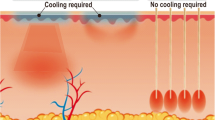Abstract
Hyperhidrosis o`ccurs when the body produces sweat beyond what is essential to maintain thermal homeostasis. The condition tends to occur in areas marked by high-eccrine density such as the axillae, palms, and soles and less commonly in the craniofacial area. The current standard of care is topical aluminum chloride hexahydrate antiperspirant (10–20%), but other treatments such as anticholinergics, clonidine, propranolol, antiadrenergics, injections with attenuated botulinum toxin, microwave technology, and surgery have been therapeutically implicated as well. Yet, many of these treatments have limited efficacy, systemic side effects, and may be linked with significant surgical morbidity, creating need for the development of new and effective therapies for controlling excessive sweating. In this literature review, we examined the use of lasers, particularly the Neodynium:Yttrium-Aluminum-Garnet (Nd:YAG) and diode lasers, in treating hyperhidrosis. Due to its demonstrated effectiveness and limited side effect profile, our review suggests that Nd:YAG laser may be a promising treatment modality for hyperhidrosis. Nevertheless, additional large, randomized controlled trials are necessary to confirm the safety and efficacy of this treatment option.
Similar content being viewed by others
References
Walling HW, Swick BL (2011) Treatment options for hyperhidrosis. Am J Clin Dermatol 12(5):285–295. https://doi.org/10.2165/11587870-000000000-00000
Doolittle J, Walker P, Mills T, Thurston J (2016) Hyperhidrosis: an update on prevalence and severity in the United States. Arch Dermatol Res 308(10):743–749. https://doi.org/10.1007/s00403-016-1697-9
Singh S, Davis H, Wilson P (2015) Axillary hyperhidrosis: a review of the extent of the problem and treatment modalities. Surgeon 13(5):279–285. https://doi.org/10.1016/j.surge.2015.03.003
Caplin D, Austin J (2014) Clinical evaluation and quantitative analysis of axillary hyperhidrosis treated with a unique targeted laser energy delivery method with 1-year follow up. J Drugs Dermatol 13(4):449–456
Schwartz RA (2017) Hyperhidrosis Treatment & Management. In: James WD (ed). Medscape. http://www.emedicine.medscape.com/article/1073359-treatment.. Accessed 15 Dec 2017
Goldman A, Wollina U (2008) Subdermal Nd-YAG laser for axillary hyperhidrosis. Dermatol Surg 34(6):756–762. https://doi.org/10.1111/j.1524-4725.2008.34143.x
Kotlus BS (2011) Treatment of refractory axillary hyperhidrosis with a 1320-nm Nd:YAG laser. J Cosmet Laser Ther 13(4):193–195. https://doi.org/10.3109/14764172.2011.594056
Letada PR, Landers JT, Uebelhoer NS, Shumaker PR (2012) Treatment of focal axillary hyperhidrosis using a long-pulsed Nd:YAG 1064 nm laser at hair reduction settings. J Drugs Dermatol 11(1):59–63
Bechara FG, Georgas D, Sand M, Stucker M, Othlinghaus N, Altmeyer P, Gambichler T (2012) Effects of a long-pulsed 800-nm diode laser on axillary hyperhidrosis: a randomized controlled half-side comparison study. Dermatol Surg 38(5):736–740. https://doi.org/10.1111/j.1524-4725.2012.02339.x
Leclere FM, Moreno-Moraga J, Alcolea JM, Vogt PM, Royo J, Cornejo P, Casoli V, Mordon S, Trelles MA (2015) Efficacy and safety of laser therapy on axillary hyperhidrosis after one year follow-up: a randomized blinded controlled trial. Lasers Surg Med 47(2):173–179. https://doi.org/10.1002/lsm.22324
Puri N (2015) Comparative study of diode laser versus neodymium-yttrium aluminum: garnet laser versus intense pulsed light for the treatment of Hirsutism. J Cutan Aesthet Surg 8(2):97–101. https://doi.org/10.4103/0974-2077.158445
Lakraj AA, Moghimi N, Jabbari B (2013) Hyperhidrosis: anatomy, pathophysiology and treatment with emphasis on the role of botulinum toxins. Toxins (Basel) 5(4):821–840. https://doi.org/10.3390/toxins5040821
Aydin F, Pancar GS, Senturk N, Bek Y, Yuksel EP, Canturk T, Turanli AY (2010) Axillary hair removal with 1064-nm Nd:YAG laser increases sweat production. Clin Exp Dermatol 35(6):588–592. https://doi.org/10.1111/j.1365-2230.2009.03638.x
Obeid G, Helou J, Maatouk I, Moutran R, Tomb R (2013) Depilatory laser: a potential causative factor for inguinal hyperhidrosis: report of three cases. J Cosmet Laser Ther 15(5):286–289. https://doi.org/10.3109/14764172.2012.761344
Acknowledgements
We would like to thank Meghan Janette for assisting in data collection for this manuscript.
Author information
Authors and Affiliations
Corresponding author
Ethics declarations
Conflict of interests
The authors declare that they have no conflict of interest.
Ethical approval
Ethical approval was not needed for this review.
Informed consent
Informed consent was not needed for this review.
Rights and permissions
About this article
Cite this article
Cervantes, J., Perper, M., Eber, A.E. et al. Laser treatment of primary axillary hyperhidrosis: a review of the literature. Lasers Med Sci 33, 675–681 (2018). https://doi.org/10.1007/s10103-017-2434-0
Received:
Accepted:
Published:
Issue Date:
DOI: https://doi.org/10.1007/s10103-017-2434-0




